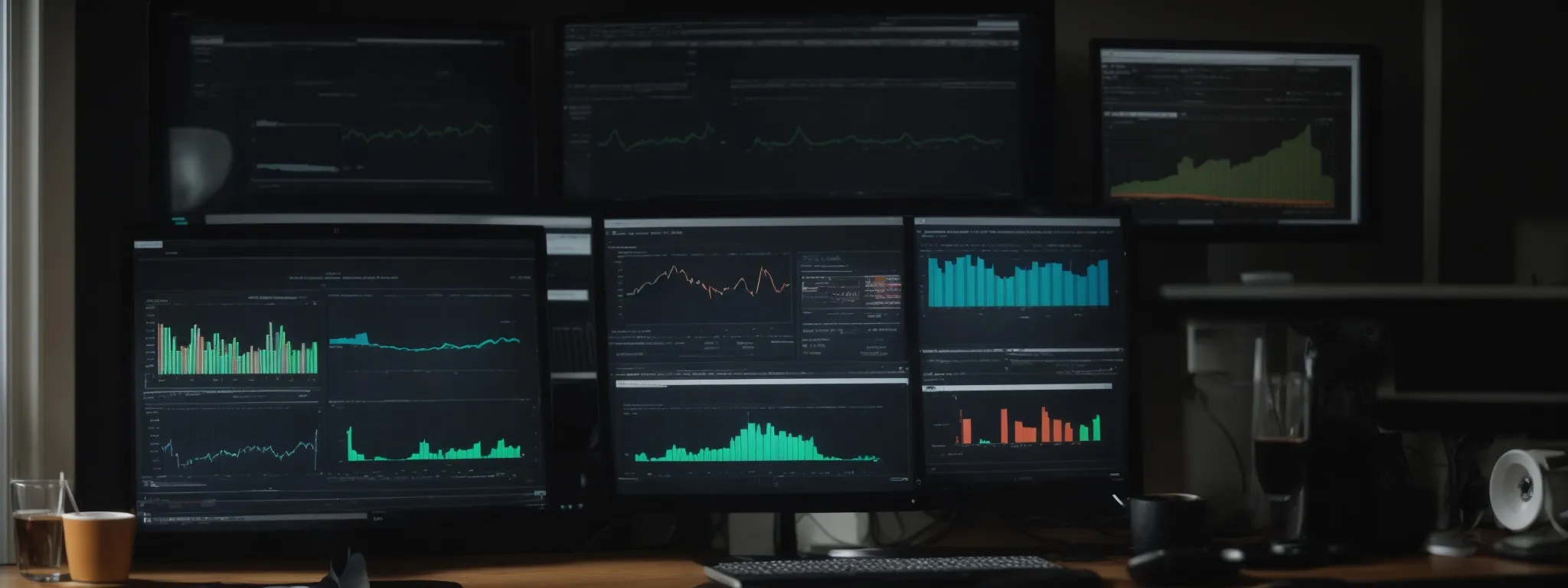Rendering in SEO: An Introduction to Critical Concepts
Understanding the Role of Rendering in SEO: A Comprehensive Introduction Search Engine Optimization (SEO) intricately intertwines with the art and science of rendering, a critical yet often […]
Understanding the Role of Rendering in SEO: A Comprehensive Introduction
Search Engine Optimization (SEO) intricately intertwines with the art and science of rendering, a critical yet often overlooked element of web development that significantly impacts search engine visibility.
With search engines evolving rapidly, understanding the nuances of rendering—how your content becomes visible to the user and crawlable for Googlebot—becomes paramount.
Rendering isn’t a mere backdrop; it’s integral in ensuring that an HTML page serves both users and search engines optimally.
As rendering modes and technologies adapt, SEO professionals must stay vigilant, ensuring adherence to best practices and seamless user experiences.
Keep reading to unravel the complexities of rendering and its pivotal role in mastering SEO dynamics.
Key Takeaways
- Rendering Influences Search Engine’s Ability to Interpret and Index Content, Directly Impacting SEO Performance
- Server-Side Rendering (SSR) Accelerates Delivery of Content, Aiding Quicker Indexation and Alignment With User Experience Priorities
- Client-Side Rendering (CSR) Introduces Complexities for SEO, Requiring Optimized Strategies to Maintain Visibility in Search Results
- Hybrid Rendering Merges SSR and CSR Benefits, Optimizing for Both Search Engine Indexation and Dynamic User Experiences
- Staying Abreast of Advancements in Rendering and SEO Best Practices Ensures Strategies Remain Effective in a Continually Evolving Digital Landscape
Explaining What Rendering Means for SEO

At the nexus of web development and search engine optimization lies a critical process known as rendering, a transformation that dictates how raw code morphs into the interactive web pages users engage with daily.
Rendering serves as a backstage mechanism, guiding search engines along a digital landscape filled with potential insights into a site’s relevance and authority.
This mechanism directly influences a search engine’s capacity to interpret and index content effectively, implicating a website’s search engine rankings and visibility.
As such, understanding rendering is pivotal for SEO professionals, who must grasp its impact on the Construction of the Document Object Model (DOM), crucial for creating SEO-friendly websites that service both user experience and the discerning eyes of search engine crawlers.
The Transition From Raw Code to Interactive Pages
The journey from source code to an HTML page that a user can interact with is not merely a straight path; rather, it is a dynamic process filled with essential transformations. This metamorphosis encapsulates the rendering phase, where scripts and styles are executed to breathe life into static text, shaping a robust experience for visitors.
During this crucial stage, various elements like script execution, API routes, and server side rendering collaborate to ensure content is visually and functionally consistent across devices. It’s a meticulous evolution, often unnoticed by the end user, yet indispensable for the integrity and accessibility of the web application:
- Source code is received by the browser or server.
- Scripts and API calls are executed to generate dynamic content.
- CSS styling is applied, formatting the layout and design.
- The browser presents the fully rendered page for user interaction.
Understanding this sequence grants insight into the significance of rendering modes in the overall SEO strategy, as different methods can greatly affect page load speed—a pivotal factor in user experience and a determinant in search engine rankings.
How Rendering Impacts Search Engine Understanding
The intricate process of rendering is more than visual appeal; it’s the critical stage where search engine bots, such as Googlebot, interpret the website’s structure and content. As search engines crawl a site, the rendering engine’s execution determines whether the content can be accurately indexed, affecting search engine results.
Without a proper rendering strategy, search engines might encounter a blank page or incomplete information, leading to suboptimal SEO performance. The rendering process ensures that search engine crawlers discern the full scope of the content just as a user would, reflecting a true representation of the site’s relevance and authority within the search engine rankings.
- Rendering converts source code into a well-structured HTML page.
- Search engines crawl and interpret the rendered HTML page.
- An accurate representation of a site’s content impacts search engine rankings.
The Role of the DOM in SEO-Friendly Websites
In the context of search engine optimization, the Document Object Model (DOM) functions as the skeletal framework supporting content visibility and indexability by search engines. A well-constructed DOM ensures that the elements of a web page are organized and accessible, enhancing the ability of search engine crawlers to digest and store information accurately.
A meticulous approach to the DOM extends beyond structure; it directly affects a website’s capacity to cater to the performance metrics that search engines prioritize. An optimized DOM contributes to faster load speeds and improved user engagement metrics such as lower bounce rates, serving as a silent yet powerful contributor to a site’s SEO health:
- Optimize the DOM for efficient crawling and indexing by search engine bots.
- Structure content to promote user engagement and site navigability.
- Implement best practices in DOM construction for optimal page performance.
The Mechanics of Search Engine Rendering

The mechanics of search engine rendering are a complex but essential voyage into the understanding of how search engines like Google interpret web content.
To unravel the nuances of this journey, SEO specialists must focus on pivotal aspects, such as the discrete steps Google employs to render web content, the implications of the render budget within an overarching SEO strategy, and the influence of the critical render path on the content’s indexability.
Each step undertaken in this procedural choreography between server and search engine is critical, striking at the heart of how content is processed, prioritized, and presented in the search engine results pages (SERPs).
Grasping these mechanics equips SEO professionals with the tactical knowledge to refine their optimization efforts for enhanced visibility.
Steps Google Takes to Render Your Web Content
In the labyrinth of digital content, Google’s search engine employs a sophisticated procedure to render web content. This process begins with the discovery and crawling phase, where Googlebot fetches a web page’s raw HTML, JavaScript, and CSS files:
- Googlebot retrieves the essential files and assets necessary to render a page.
- The search engine’s rendering engine then parses and executes JavaScript to build the DOM.
- Rendering completes as Googlebot generates the fully-constructed page that resembles user experience.
Upon constructing the DOM, Google’s rendering engine evaluates the completed HTML page, ensuring all components are aligned with SEO best practices. This meticulous audit is pivotal, as the final rendered content must clearly communicate a website’s thematic elements to align with relevant search queries and secure a commanding position within search engine results.
Exploring the Render Budget in SEO Strategy
Within the framework of SEO strategy, the concept of a render budget emerges as a crucial consideration for optimizing websites. This budget refers to the limited resources search engines are willing to allocate for rendering a given web page, with the overarching aim to crawl and index the internet efficiently.
Professionals in the field understand that balancing the demands of sophisticated web features with the constraints of the render budget is vital. Optimization involves prioritizing critical content and functionality above the fold to ensure it’s processed within this budget, thereby enhancing the likelihood of favorable SERP positions and maintaining seamless user engagement.
How the Critical Render Path Affects Indexing
The critical render path outlines the sequence of events the browser undertakes to convert the code into a functional user interface, which holds significant implications for how content becomes indexable. By clearly defining which resources are necessary for the initial page render, a website can be meticulously tuned to showcase its most valuable content to search engine algorithms quickly and effectively.
Indexing efficiency hinges on an optimized critical render path as it shapes the first impression that search engine bots receive of a site. When this path is streamlined, search engines can more rapidly understand and index a website’s core offerings, solidifying its position within the competitive landscape of search engine results.
Rendering Issues That Hurt SEO Performance

In navigating the complexities of search engine optimization, professionals must be vigilant in identifying and resolving rendering issues that can significantly diminish a website’s visibility and ranking potential.
Critical rendering problems often stem from an overreliance on heavy JavaScript, extensive use of resources that ultimately lead to sluggish loading times, and other related obstacles.
By pinpointing these common rendering challenges, SEO experts can strategize troubleshooting methods that sharpen search visibility and refine the overall user experience, thereby reinforcing a site’s standing in the competitive digital arena.
Identifying Common Rendering Problems
Spotting rendering issues that hinder SEO efficacy involves a discerning look at how web pages are processed by search engine crawlers. Observable signs of inefficiency often include the search engine bot’s prolonged pauses on non-optimized pages or the crawler’s failure to index parts of a web page, which can signal underlying complications in JavaScript execution or server-side configurations.
Professionals in SEO must watch for the telltale discrepancies between what a user sees and what the search engine bot is able to render and comprehend. A gap in this parity can suggest rendering defects, such as improper implementation of SSR or CSR techniques, potentially leading to incomplete indexing of content and an adverse effect on the site’s visibility in search engine rankings.
The Impact of Heavy JavaScript on SEO
The employment of heavy JavaScript presents a notable hurdle in SEO, as it can lead to increased page load times—detrimental to both user experience and to the site’s ability to be readily indexed by search engines. Search engine crawlers, in their aim to efficiently map the web, often allocate limited time to render a page’s contents: excessive JavaScript can exhaust this time before the page is fully processed.
This excessive JavaScript usage often requires search engines to expend additional resources, which may impede the site’s content from being indexed swiftly and correctly. In consequence, web pages steeped in JavaScript may not be presented or ranked as effectively within search engine results, impacting overall SEO performance.
| SEO Factor | Impact of Heavy JavaScript | SEO Outcome |
|---|---|---|
| Page Load Time | Increases | Decreases user satisfaction and search ranking potential |
| Crawler Resources | Over-consumption | May lead to incomplete indexing and visibility issues |
| Content Indexing | Delayed/Indexing errors | Reduced presence in search results |
Troubleshooting for Improved Search Visibility
To fortify search visibility in the face of rendering challenges, SEO experts at LinkGraph employ a strategic array of remedies with their SEO services. Initiating with their free SEO audit, the team meticulously analyzes a website, unearthing hurdles in rendering that obstruct indexation and search engine visibility, thus paving the way for targeted optimizations.
LinkGraph’s suite of advanced tools, such as the SearchAtlas SEO software, provides an invaluable resource in this troubleshooting process. Offering insights through free backlink analysis, the software allows specialists to modify on-page elements, enhancing the website’s rendering efficiency and securing its prominence in search engine results, a cornerstone of white-label SEO services.
Server-Side vs. Client-Side Rendering in SEO

In the intricate tapestry of search engine optimization, rendering unfolds in two primary narratives: server-side and client-side.
Each approach commands its own set of advantages and challenges that, when navigated astutely, determines the efficacy of a website’s search engine indexation and ranking.
Server-side rendering (SSR) is celebrated for its prompt delivery of content to search engines, thus facilitating faster indexation.
Conversely, client-side rendering (CSR) presents distinct dilemmas, requiring an SEO adept approach to ensure visibility.
Bridging these methodologies, hybrid rendering emerges, beckoning with the promise of integrating SSR’s rapid indexability with CSR’s dynamic possibilities, crafting a cohesive strategy aimed at dominating search engine results.
Advantages of Server-Side Rendering for Fast Indexation
Server-side rendering (SSR) offers a decisive advantage for SEO through its accelerated delivery of content to search engines, thereby enabling a quicker indexation process. By pre-rendering the HTML on the server, SSR ensures that search engine crawlers are met with fully formed pages, streamlining the path to content discovery and reducing the time to visibility within SERPs.
The immediacy with which SSR serves content not only satisfies the swift appetite of search engine bots but also aligns with user experience priorities, offering readily available content upon the initial request. This alignment supports enhanced SEO performance, as search engines like Google prioritize quick loading times and efficient access to information when ranking and indexing web pages.
Client-Side Rendering Challenges for SEO
Client-side rendering (CSR), while offering interactivity and dynamism to user experiences, introduces SEO intricacies due to the browsers’ responsibilities in constructing the DOM. This method’s dependence on client-side JavaScript to render content can result in delayed content visibility for search engines, presenting hurdles for immediate content indexing and potentially affecting search engine rankings.
In the landscape of search engine optimization, CSR’s challenge lies in the asynchronous nature of content rendering, with search engine crawlers possibly missing dynamic content that loads post the initial page render. Optimization strategies must therefore account for these limitations, ensuring critical content is accessible to search engine bots to maintain a website’s competitive edge in search engine results.
Hybrid Rendering Techniques for the Best of Both Worlds
Hybrid rendering techniques skillfully merge the strengths of server-side and client-side rendering to cultivate an optimized digital presence. This adaptive strategy enables websites to enjoy the SEO benefits of quick load times from SSR while still delivering the dynamic user experiences enabled by CSR.
With a hybrid approach, developers can craft web applications that render static content from the server for search engine crawlers, while also allowing clients to handle dynamic interactions seamlessly. This duality caters to the rigorous demands of both users and search engine algorithms, fostering an environment conducive to improved performance in search rankings.
- Combine SSR’s advantage in speed with CSR’s user experience enhancements.
- Leverage server-side rendered pages for immediate indexability.
- Utilize client-side JavaScript for enriching the application with interactive elements post initial page load.
Tools to Test and Improve Website Rendering

In the quest to optimize search engine visibility, the fidelity of a website’s rendering process becomes a paramount concern for SEO professionals.
Sophisticated tools have been developed to inspect and enhance the nuances of how a site is rendered to search engines—these range from utilizing Google Search Console for monitoring essential rendering signals to engaging third-party solutions that scrutinize rendering efficiency.
Integral to honing a website’s performance are the metrics that pinpoint potential rendering issues; such insights steer the optimization trajectory, ensuring search engines and users alike experience a website at peak functionality.
This section delves into these pivotal tools and metrics, forging a path to superior rendering and, subsequently, amplified search engine traction.
Using Google Search Console to Monitor Rendering
Google Search Console stands as an indispensable asset for SEO professionals aiming to monitor and enhance their websites’ rendering. By providing detailed reports, it allows users to identify how pages are rendered by Googlebot, spotlighting critical areas that may require optimization.
The multifaceted diagnostic features of Google Search Console assist in the vigilant tracking of rendering issues, ensuring that both the search engine and the visitor access a fully optimized, accurately displayed version of the website:
- Examine the rendering of pages as seen by Googlebot to ensure accuracy and completeness.
- Analyze detailed crawl statistics to identify and address rendering obstacles that could impede search engine visibility.
- Utilize the URL Inspection tool to test and optimize the rendering of specific pages for improved search engine performance.
Third-Party Tools to Analyze Rendering Efficiency
For SEO professionals intent on optimizing rendering, an array of third-party tools offers deep analytical insights. These resources enable a meticulous evaluation of client-side and server-side rendering performance, providing clear directives for enhancing SEO outcomes and overall page efficiency.
The toolset extends from detailed page speed analyzers to comprehensive auditing platforms, which assess the critical render path and detect JavaScript rendering issues:
- Investigate particular elements that impede optimal load speed and user experience.
- Provide actionable resolutions for identified rendering inefficiencies.
- Encompass a wealth of data-driven metrics to guide SEO practitioners in fine-tuning rendering processes for maximal search engine receptivity.
In this digital era where site performance is tantamount to visibility, these sophisticated tools are invaluable companions in the quest to elevate a site’s standing in the search engine results page through superior rendering optimization.
Performance Metrics That Signal Rendering Issues
In the pursuit of optimizing a website’s rendering and, by extension, its SEO performance, it is essential to consider specific performance metrics that are indicative of rendering issues. These metrics encompass aspects such as the First Contentful Paint (FCP) and Time to Interactive (TTI), which reflect the time it takes for a page to start showing content and become functional for the user, respectively.
When anomalies are detected in these critical metrics, they often point to rendering problems that could hinder a website’s search engine results. For instance, a delayed FCP might indicate rendering delays associated with server response times or render-blocking resources:
| Performance Metric | Rendering Issue Indicator | Potential SEO Impact |
|---|---|---|
| First Contentful Paint (FCP) | Delayed content rendering on the page | Compromised user experience leading to reduced engagement |
| Time to Interactive (TTI) | Extended delays in page interactivity | Potential increase in bounce rates affecting search rankings |
| Cumulative Layout Shift (CLS) | Frequent layout changes during loading | Negative influence on user experience and perceived page stability |
| Largest Contentful Paint (LCP) | Slow loading of the main content | Adverse effect on user satisfaction and dwell time |
Optimizing Content Delivery for Better Rendering

In the quest for superior Search Engine Optimization, the rendering of web content stands out as an essential factor influencing how quickly and accurately search engines can access, interpret, and render a website for users.
Mastering efficient content delivery is key to improving rendering and, in turn, primes a site for better search engine rankings.
This involves embracing techniques to expedite content loading, ensuring that above-the-fold content is rendered without delay, and reducing reliance on resources that obstruct the seamless presentation of a page.
By scrutinizing these facets, SEO experts can significantly refine a website’s performance, ensuring both search engine readiness and optimal user experience.
Techniques for Efficient Content Loading
To enhance the rendering efficiency of web content, deploying techniques that Streamline Content Loading is indispensable for SEO specialists. Among these strategies, leveraging browser caching and minimizing HTTP requests stand out, effectively reducing the volume of data transferred between the server and client, thus accelerating page load times.
Implementing responsive images and lazy loading also plays a pivotal role in content loading efficiency: these practices ensure that resources are only loaded as needed, preventing unnecessary strain on bandwidth and enhancing the user’s navigation experience:
- Utilize browser caching and minimize HTTP requests to lower data transfer.
- Employ responsive image techniques to adjust visuals to the user’s screen.
- Adopt lazy loading to defer loading off-screen resources until necessary.
By prioritizing the delivery of critical content and optimizing server response times, SEO professionals bolster rendering performance, thereby improving a site’s visibility and standing in search engine results. Such meticulous optimization directly correlates with improved user engagement metrics, a cornerstone for success in the competitive digital landscape.
Prioritizing Above-the-Fold Content Rendering
Efficient rendering of above-the-fold content is crucial for capturing user attention and reducing bounce rates. This immediate content area is what users encounter first, making its quick load time nonnegotiable for maintaining user interest and improving the probability of a strong search engine ranking.
LinkGraph’s Approach to optimizing above-the-fold content ensures that critical information is immediately accessible to both users and search engine crawlers. By optimizing what’s visible in this initial viewport, websites witness a marked improvement in user experience and search engine appreciation:
- Streamline critical above-the-fold content to load swiftly.
- Reduce JavaScript payloads that may delay rendering.
- Implement CSS techniques to position key content prominently.
The prioritization of above-the-fold rendering directly influences a positive user interaction from the moment a page begins to load. SEO strategy guided by LinkGraph’s expertise focuses on this rendering aspect to cement a website’s prominence in the hierarchy of search engine results.
Minimizing Dependence on Blocking Resources
Minimizing the dependence on render-blocking resources is crucial for enhancing content delivery across websites. These are often JavaScript or CSS that hinder the speedy display of web content, directly impacting a site’s load time and user accessibility.
SEO specialists at LinkGraph meticulously streamline the critical rendering path by deferring nonessential scripts and styles that obstruct the initial paint of web pages. This protocol dramatically improves the user’s first impression and contributes to more favorable search engine rankings:
- Defer non-critical JavaScript to ensure it does not block the rendering of main content.
- Inline essential CSS directly into the HTML to accelerate style application.
- Utilize asynchronous loading for scripts that are not required upon initial page load.
Future Trends in Rendering and SEO Integration

As search engine algorithms evolve and web technologies advance, industry professionals observe a shifting landscape in rendering’s role within SEO.
The burgeoning relevance of JavaScript frameworks presents a significant shift in optimizing content for search engines, requiring a nuanced approach to SEO methods that cater to these modern development practices.
Progressive Web Apps (PWAs) also enter the fray, bringing a new caliber of user experience that melds the best of web and mobile apps, yet poses fresh challenges for SEO-friendly rendering techniques.
Anticipating future enhancements in Google’s rendering abilities remains a key focal point, as SEO experts endeavor to align their strategies with potential algorithmic evolutions, remaining agile in a domain known for its constant state of flux.
The Rising Importance of JavaScript Frameworks in SEO
The advent of JavaScript frameworks has undeniably transformed the digital landscape, establishing novel paradigms for how content is delivered and rendered. Modern frameworks such as React and Angular Universal bring forth dynamic capabilities, compelling SEO experts to adapt their strategies to ensure content remains discoverable and indexable in a JavaScript-heavy ecosystem.
As these frameworks become integral to web development, their impact on SEO is profound, necessitating a deeper comprehension of how search engines interact with JavaScript. This necessitates a Meticulous Rendering Approach, pushing SEO professionals to collaborate more closely with web developers to mold SEO-friendly, JavaScript-rich web applications that align with search engine protocols.
Progressive Web Apps and SEO-Friendly Rendering
With the proliferation of Progressive Web Apps (PWAs), the intersection between mobile-like experiences and traditional web environments challenges SEO practitioners to refine their rendering optimization tactics. PWAs leverage modern web capabilities to deliver fast, engaging, app-like experiences, mandating that search engines effectively parse through service workers and app shells, critical components often used in these applications, to maintain accuracy in indexing and rendering.
As SEO professionals prioritize the agility and performance of PWAs, the call for rendering optimizations that account for these applications’ unique features grows louder. Ensuring that PWAs are both rapidly discoverable and seamlessly functional entails a thoughtful approach to their content’s rendering processes, acknowledging that the balance of speed and user experience is paramount in their integration with SEO strategies.
Predicting Changes in Google’s Rendering Capabilities
Anticipating Google’s advancements in rendering is essential for SEO specialists poised to leverage emerging opportunities. As Google continues to enhance its capacity to render JavaScript-heavy sites more comprehensively, the SEO landscape may see profound changes in rank attribution and site visibility.
The vigilant SEO professional must keep abreast of these developments, understanding that today’s best practices might evolve tomorrow. Staying informed allows for proactive adjustments, ensuring strategies remain in lockstep with Google’s sophisticated rendering techniques.
- Monitor Google’s updates to render JavaScript effectively.
- Adapt SEO strategies to align with improvements in Googlebot’s capabilities.
- Anticipate the integration of new rendering technologies into SEO best practices.
Conclusion
Understanding the role of rendering in SEO is vital for online success.
Rendering transforms raw code into interactive, indexable web pages, directly affecting a website’s search engine rankings and visibility.
Crucial to SEO, rendering dictates how search engines like Google interpret a site’s content, ensuring accurate indexing and relevance.
Efficient rendering supports a well-constructed DOM, enhancing crawlability, user engagement, and performance metrics — all of which are key to a strong SEO profile.
SEO professionals must navigate server-side and client-side rendering to optimize content delivery, prioritizing above-the-fold content and minimizing render-blocking resources.
Tools like Google Search Console and third-party solutions help identify and resolve rendering issues, improving search visibility.
With the advancing role of JavaScript frameworks and Progressive Web Apps, staying informed on rendering trends becomes indispensable, enabling SEO strategies to evolve in line with search engines’ capabilities.
In essence, mastering rendering in SEO is a strategic imperative for those seeking to maintain competitive advantage and improved user experiences in the ever-evolving digital landscape.















































































